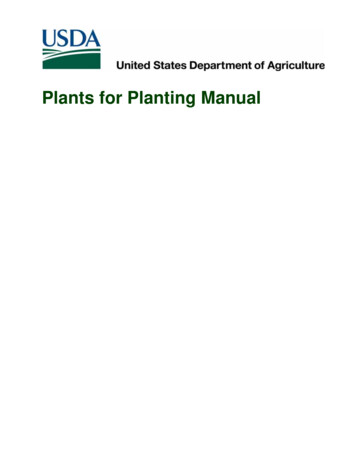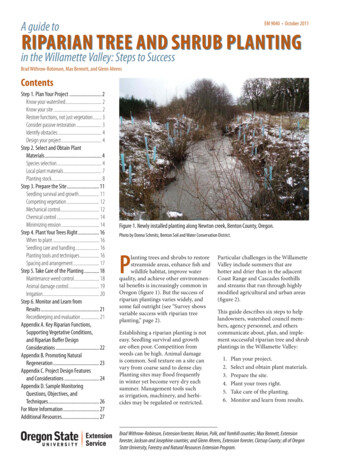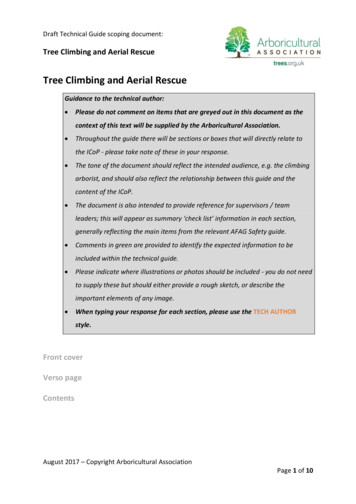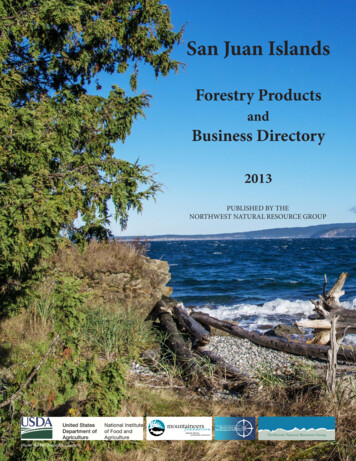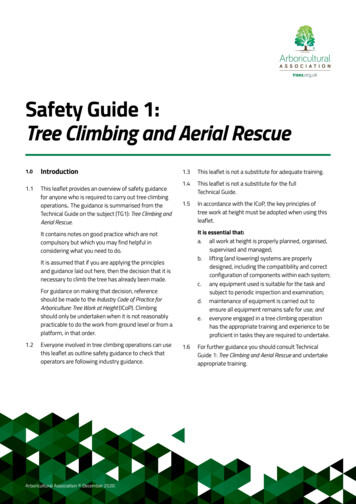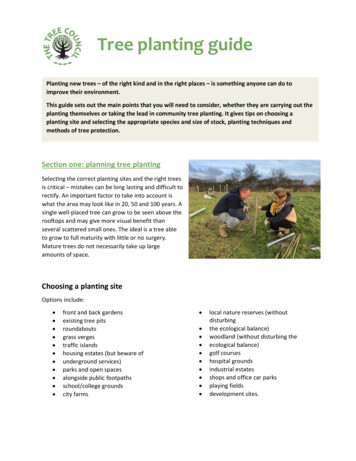
Transcription
Tree planting guidePlanting new trees – of the right kind and in the right places – is something anyone can do toimprove their environment.This guide sets out the main points that you will need to consider, whether they are carrying out theplanting themselves or taking the lead in community tree planting. It gives tips on choosing aplanting site and selecting the appropriate species and size of stock, planting techniques andmethods of tree protection.Section one: planning tree plantingSelecting the correct planting sites and the right treesis critical – mistakes can be long lasting and difficult torectify. An important factor to take into account iswhat the area may look like in 20, 50 and 100 years. Asingle well-placed tree can grow to be seen above therooftops and may give more visual benefit thanseveral scattered small ones. The ideal is a tree ableto grow to full maturity with little or no surgery.Mature trees do not necessarily take up largeamounts of space.Choosing a planting siteOptions include: front and back gardensexisting tree pitsroundaboutsgrass vergestraffic islandshousing estates (but beware ofunderground services)parks and open spacesalongside public footpathsschool/college groundscity farms local nature reserves (withoutdisturbingthe ecological balance)woodland (without disturbing theecological balance)golf courseshospital groundsindustrial estatesshops and office car parksplaying fieldsdevelopment sites.
Assessing a siteHere are some important points to consider about a site. Ownership of the landTrees may only be planted with the landowner’s permissionWill the owner carry out planting?If not, will permission be given for planting?Can planting be planned to meet the owner’s objectives and also benefit the community?What is the foreseeable future of the site (and therefore the trees)? Seek assurancefrom the owner.Who will look after the newly planted trees? This needs to be agreed.Proximity to buildings and other structuresMany recent buildings will have adequate foundations to enable selected trees to be planted nearby.Tree-related subsidence usually occurs only on shrinkable clay soils where foundation damage mayresult from roots extracting water.Poplars and willow species should be planted with caution in built-up areas on clay as they require somuch water.See section 6, Trees – threats and challenges.Ultimate size of the proposed treeTrees grow in height and spread over a life of 100 years or more, and might eventually cause problemsin terms of shade, light and building foundations.What will be the ultimate spread and height of the tree?How far will the roots spread? They may extend as much as twice the ultimate height of the tree.See section 6, Trees – threats and challenges.Safety concernsThere are some sites where planting trees could be hazardous.Before carrying out any work, it is vital to check whether any services are likely to be runningunderground. Seek advice from the local authority about this.Trees will require constant pruning in order to maintain statutory clearance if planted under overheadservices (such as electricity cables and phone wires).Trees should not be planted where they could obscure road sight lines, road signs or street/securitylighting.The local ecologyEcological factors may mean that it is best not to plant trees at all.
Is natural regeneration already taking place? If so, this may be preferable for wildlife.Is the site already valuable tree habitat, like thickets and old orchards, whichshould normally be retained?Will trees shade out old grassland, streams or ponds, or damage heath, peat or very damp ground suchas bogs (which should be left unplanted)?Are there good reasons for the site being treeless (e.g. it is heavily grazed, tooexposed, thin or polluted soil, or waterlogged ground)?Choosing the right species Copy nature by planting trees already successful on or near the site.For a rural site, choose species in keeping with the existing woodland.In urban areas, options range from ornamental planting schemes to creating new ‘natural’areas.Choose species for urban areas that are tolerant of atmospheric pollution and soilchemicals such as road salt (see also section 6, Trees – threats and challenges).Consider the eventual height and spread of trees in relation to nearby roads, buildings andoverhead lines.Fallen fruits from trees such as hybrid hawthorns and rowans make pavements slippery.Large leaves from species like horse chestnuts may also make pavementsslippery.Trees which extract moisture from shrinkable soil may affect nearbyfoundations.Trees that produce poisonous fruits (e.g. yews and laburnum) are unsuitable for children’s playareas and where animals graze.Trees with fruit that causes stomach-ache (e.g. crab apples) are best avoided nearplay areas.Some trees, like white poplar, false acacia and wild cherry, have suckers and surface roots whichmay disrupt paving or light structures such as boundary walls.Trees casting dense shade and reaching large dimensions, such as oaks and beeches, can shadewindows and gardens.Choosing the right size of stockOnce the tree species has been chosen, the next step is to select the planting stock.Generally, the smaller a tree is when planted, the more readily it becomes established and begins togrow.This is because small trees have a relatively large root system in relation to their canopy or leaf surfacearea. This means the aerial portion of the tree can be well supplied with water, oxygen and mineralswhich are essential once a tree has started into growth.
It is not uncommon for a self-set tree seedling or whip to outgrow a larger tree (even one that is wellmaintained) and reach maturity before it.However, if the aim is to have instant effect, it is a good idea to choose a standard or semi-mature tree.Seedlings, transplants and whips Very cheap – so a good way to achieve large-scale planting.Easy to plant – so ideal for community/school planting involvingvolunteers.Readily stands the stress of transplanting.Feather Relatively cheap – so still practical for large projects.More likely to be damaged or stressed during planting than smaller stock.Requires more skill in planting because it needs to be well-anchored in the soil toreduce the risk of wind damage.Standard Relatively expensive to buy and also requires more planting preparation.Less susceptible to damage during planting than smaller stock.A good way to achieve immediate impact in gardens, streets or shopping precincts.Heavy standard An expensive option.Good for achieving effect in prestigious sites.Semi-mature The most expensive option.Achieves instant impact but needs very careful planting and a great deal of maintenance(particularly watering) for a long time after planting.Normal trade descriptions of trees of various sizes – used throughout the nursery tradeSeedling height: 0.2 to 0.9m (8in to 3ft)Whip height: 1m to 1.75m (3ft 3in to 5ft 9in)
Transplant height: up to 1.25m (4ft)Feather height: 1.25 to 2.5m (4ft to 8ft )Multi-stemmed height: various(From left)Standard with leader height: 2 to 3.5m (6ft 6in to11ft 6in)Standard with branching head height: 2 to 3.5m(6ft 6in to 11ft 6in)Also available are:Heavy standard same as standard but height3.5m (11ft 6in) or more, girth 140mm (5in)Semi-mature size variesTypes of stock As well as being available in different sizes, trees are produced in different types ofstock.Bare-root – grown in open ground, dug up in winter and sold with no soil covering the roots;usually small stock, i.e. whips and feathers.Root-balled – like bare root but sold with a covering of soil and wrapped in hessianfor transportation; usually larger stock, i.e. standards and upwards.Containerised – like rootballed but put into a container for sale.Container-grown – most common type of stock in garden centres; all sizes are now available.Obtaining treesOne way to obtain new trees is to grow them from seeds or by taking cuttings or grafts (see section 3,How to grow your own trees). If this is not an option, here are points to consider when buying them.Ordering trees
If ordering native species, check their origin and be wary if the nursery is unable to supply theinformation. Some nurseries list the origin of each species intheir catalogues. Some nurseries will raise plants from seed of acceptable origin if collected andsupplied by the customer.Place orders early with a reputable nursery to ensure a prompt delivery; if possible stipulate adate.Local suppliers, listed in the Yellow Pages under ‘Nurseries – Horticultural’or ‘Garden Centres’, willmostly specialise in containergrown ornamental stock. However, many will supply other types of tree toorder. For sources of native trees in quantity, a good starting point is the local wildlife trust or BTCVoffice, or even the local authority officer.For large numbers of trees it is best to place orders by July or August for supply in the lateautumn/winter. Beware of accepting substitute tree species which seldom have the desiredcharacteristics of the plants ordered. Inspect the trees as soon as they arrive and return themimmediately to the nursery if they are unfit for planting: e.g. have broken leading shoots or sidebranches, damaged bark or dried-out and damaged roots. For container-grown trees, check they are notpot-bound.Section two: planting the treesTo give new trees the best possible start and the greatest chances of survival, there are a number of keyconsiderations.When to plantBare-root trees should be planted during the dormant season. Container-grown trees can be planted allyear round. In all cases, avoid days when the ground is frozen.A good time to plant is during The Tree Council’s National Tree Week (end of November – beginning ofDecember). In dry areas, late autumn planting is best for most species as this gives trees a chance tobecome established before spring droughts. In wet areas, early spring planting is best.Ideally, the site should be drained of excess water. Where soils are wet and then freeze there is a risk of‘frost lift’ which can devastate newly planted trees, though this is unlikely in most years. Evergreen treesare best planted either early or late in the planting season. Spring planting should not take place untilthe soil has begun to warm. Although container-grown trees can be planted at any time of year, thesame guidelines will give best results for them too.If planting is in late spring or summer, container-grown trees should be watered during dry spells for thefirst growing season (see section 5, Managing and caring for trees).Pre-planting careMany bare-root trees are already dead when planted. This is often because of careless handlingbetween the time they are lifted from the nursery and final planting-out.Unfortunately, these trees are not easy to identify before planting and the first sign of a problem may bewhen they fail to grow.
It is essential to ensure that: bare-root trees are delivered with their roots wrapped in plasticif not planted immediately, bare-root trees are removed from the bags and heeled-in, seediagram (for 24 hours or less, bags of trees may be stored in a cool shady position out of thewind)as much short fibrous root is kept on the trees as possibletrees are safeguarded from damage, such as broken stem tops and bark stripped from stem orrootstrees are stored only where there is free drainage, so that they do not stand in waterloggedconditionsroots are protected from heat.Ideally, trees should be lifted, transported and replanted without interruption.However, they may need to be stored before planting and the best way to store bare-root trees is byheeling-in.Heeling-inDig a trench in good fresh moist soil which will not dry out or become waterlogged. Cultivated nurseryground is ideal, provided it is shaded. Dig the trench with a sloping back, deep enough for the treeroots to be completely covered.Trees in bundles should be separated and spaced along the trench, otherwise those in the centre maydry or – in the case of evergreens – heat up. Putting a marker stick every 50 or 100 trees savescounting later. Place the trees with their roots completely in the trench but with their tops out. Coverthe roots with soil and firm it lightly by treading.Preparing the groundBefore trees are planted, the ground may need some preparation, particularly in urban areas where soilcompaction is often a problem.Compaction can happen on brownfield sites, on land where there is a plough pan (an area of the groundcompacted by frequent ploughing) and on new development sites (see section 6, Trees – threats andchallenges).
In severe cases it stops the tree roots from establishing, so the trees fail to grow well and mayeventually die. If the planting site suffers from soil compaction then ideally the area should be subsoiled.This is a process that loosens the soil and breaks up the compaction or plough pan. It is usually donewith a mechanical digger.If subsoiling is not practical, a solution can be to plant in large planting pits where material has beenintroduced to improve drainage and add nutrients.Planting small treesThere are three ways to plant small trees: notch plantingturf plantingmound and ridge plantingNotch plantingNotch or slit planting with a garden spade is the quickest, but not the most reliable, method for plantingsmall trees. It is generally suitable for mass planting of bare-rooted transplants and whips under 90 cm(3ft) high. It should not be used in wet soil, for large or expensive trees or where failures must beminimised.Where there is a thick grassy mat, clear a barepatch about 0.5metre (19in) in diameter byscraping off vegetation and the top inch or so ofsoil with a spade or mattock.Use the spade to cut through the turf into the soilto a depth that will accommodate the roots ofthe tree being planted.
Push the spade backwards and forwards in theslot to create a hole large enough for the roots.Hold the tree in place and firm the soilaround the stem with the heel.Turf plantingThis method is useful for planting small trees in wet ground, especially peaty soils, as it improvesdrainage around roots.Cut out a square of turf and turn it grass side down. Cut a notch into the turf and soil below. Insert theroots, then firm.Mound and ridge plantingFor poorly-drained sites where the turf is difficult to cut, mound planting provides extra freely-drainingsoil for roots. In all cases it is important to apply a mulch at the time of planting because this will reducethe need to weed and water, helping to ensure the survival of the tree (see section 5, Managing andcaring for trees).In all cases it is important to apply a mulch at the time of planting because this will reduce the need toweed and water, helping to ensure the survival of the tree (see section 5, Managing and caring fortrees).
In some cases it may be possible to arrange forthe site to be ploughed to create ridges andfurrows to improve drainage.In exposed sites, plant on the downwind side ofthe mound/ridge.Protecting trees from damageTrees, especially when young, are extremely vulnerable to damage from animals and people. Protectionrequires planning.Points to consider Cost: protective measures can add considerably to initial costs. It is usually cheaper to protectgroups rather than individual trees.Maintenance: all forms of protection add to maintenance costs.Appearance: protection can sometimes be unsightly.Land take: protective measures often reduce the land available for other uses.Susceptibility to animal damage: is the species of tree particularly susceptible?Could a more resistant species be planted?The choice: fences, guards or sheltersThe cost of individual tree protection increases with the number of trees, but fencing costs relate to thesize and shape of land enclosed, irrespective of the number of trees. Long, thin or complex shapes arethe most uneconomical to fence, with squares and wide rectangles being the cheapest.Tree shelters (wire mesh or plastic) are the most common tree protection for plantings of less than ahectare (2.5 acres). For larger areas, perimeter fencing is usually cheaper, but it will not deter rabbits orsquirrels.Shelters make it easier to locate newly planted trees for weeding and maintenance.They also protect against damage by animals and herbicide around the base. Plastic shelters act likemini-greenhouses. Growth can be up to five times the normal rate in the first two years.Methods of tree protection Stock-proof fencing: essential if animals are to graze nearby. Fencing must be at least twometres from any new planting.
Rabbit-proof fencing: around plantations where there is a problem – but ensure the rabbits arenot fenced inside.Shelters for individual trees: it is important to find out which animals are likely to threaten thesurvival of newly planted trees and then use shelters and stakes of the appropriate height.ShelterStakeAnimals0.6m (2ft)0.8m (2ft 6in)Rabbits and hares1.2m (4ft)1.2m (4ft)Sheep and roe deer1.8m (6ft)1.8m (6ft)Fallow, sika and red deer1.8m (6ft)Heavy dutyCattle and horsesRabbit sleeves, spirals, Netlon guards and growtubesThere is a risk that spiral guards will unravel anddamage the tree.Extruded plastic tubes protect individual trees.The top of any stake must be below the top ofthe tube to prevent the tree chafing later.Push the end of the guard into the ground aroundthe base of the tree.
Make sure tall shelters are well attached to firm,strong stakes so that the shelter does not moveand damage the tree.There are various types of extruded plastic tubes,but all have the same function. There are alsodifferent ways of attaching them to a stake.Using tree tiesUsing wire or zip tiesTree guardsStout, tall metal guards deter vandalism ofindividual standard trees.
Planting large treesAlthough labour-intensive, pit planting is the best method for large trees because it ensures plenty ofroom for the roots. It is essential for trees over 90cm (3ft) tall. It is also worthwhile when planting only afew trees or where failures would be expensive or difficult to replace.Pit plantingIn good soil, dig a hole big enough for all theroots to spread out. In poor soil, dig a hole widerand deeper than needed for the roots, and partlyrefill. Consider adding a soil improver.Gently tease out the roots that have woundaround the inside of the pot.Keep the top of the rootball level with theBreak up compacted soil to improve drainage andaerate the roots.Use a stake if the tree is over 1.5m (5ft).Drive the stake into the bottom of the pit andthen place the tree on the downwind side.Stakes should not be more than a third of theheight of the tree.Backfill and gently shake the tree up and
soil surface.Clear grass and weeds for an area ofapproximately 1m (3ft) diameter around the tree,and apply a layer of mulch. For moreinformation about mulches and how toapply see section 5, Managing and caring fortrees.down to ensure a good contact betweenroot and soil. Once the roots are coveredcontinue treading more firmly until the holeis over-filled, leaving the soil slightly abovethe surrounding ground.Treading in ismost important when pit planting. Manyfailures are due to lack of firming. In heavysoils, do not firm so much that the soilbecomes compacted.Water the tree.Drench the soil with at least five litres of water.The amount will depend on the size of the treebeing planted.Watering tubesWhether to use a watering tube will depend onthe situationHeavy standards planted intopavements are often planted with a wateringtube to make it easier to get large quantitiesof water to the roots. However, this mayencourage roots to stay within the planting pitand not grow into the surrounding ground.Staking and tying large treesRecommendations for staking trees have changed in recent years. Tying a tree just below the start ofthe crown using a tall stake is not now recommended. This is because the stem cannot sway, so littleincrease in stem diameter occurs from crown to base.Swaying in the wind stimulates growth of stem diameter.
With no stake, the whole tree sways, stimulating maximum diameter growth near the root collar (i.e.the transition from stem to root). Where support is necessary (normally if the tree is more than 1.5m[5ft] tall), stake the tree sufficiently to anchor the rootball in the ground, but allow the stem tosway in the wind.For large trees, two-thirds of the stake should be below ground. It needs to be driven into the base ofthe pit to make it stable.Using a single stakePosition the stake first, on the side of the tree facing towards the prevailingwind, to reduce chafing in storms. Position the tree 25 to 50mm (1 to 2in) fromthe stake.Attaching tree ties with padsFix the pad 25mm (1in) from the top of the stake.Thread the belt through and either fasten the buckle or tack as shown to allowadjustment as the tree grows.The right size of pad is important. If it is too small it can split as the tree grows.The belt should form a loop and not be drawn in tightly by the pad.No stake should extend higher than a third of the height of the stem. Use asingle flexible tie, to allow movement. Old inner tubes and tights are suitable,though not particularly attractive. A pad between the stake and the tree isalways necessary.If trees are well tended, roots should have grown enough to anchor them twoyears after planting, when stakes should be removed. Sometimes it is bestsimply to cut off the stake at soil level, being careful not to damage the bark.This will avoid disturbing the roots.
Other methods of staking treesThere are also various methods for staking trees in particular situations.Guy ropesOnly suitable for large heavy standard trees onsites where there is no risk of people tripping.Double stakeFor windy exposed sitesAngled stakeUsed for trees with a large rootball. Driven into the ground after planting.Find out more Hillier’s Gardeners Guide to Trees and ShrubsCollins Tree GuideThe Garden Tree, Alan Mitchell and Allen CoombesEncyclopaedia of Gardening, RHSTrees in Your Ground, The Tree CouncilTrees: Their Use, Management, Cultivation and Biology.A comprehensive guide, Bob WatsonReferences1. Tree Roots and the Built Environment – Urban soils for amenity trees, page 79, DCLG Researchfor Amenity Trees No 8
This guide sets out the main points that you will need to consider, whether they are carrying out the . They may extend as much as twice the ultimate height of the tree. See section 6, Trees – threats and challenges. . To give new trees the best possible start and the greatest chances of sur
